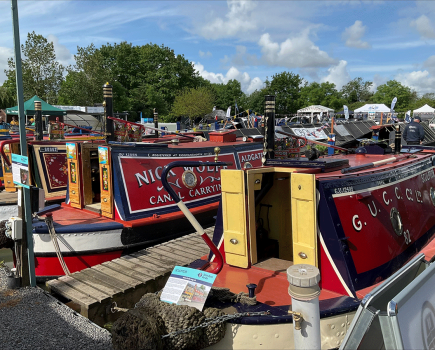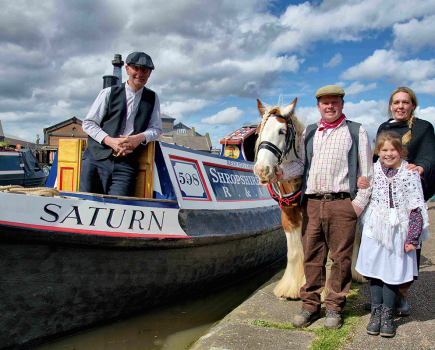Did the coming of railways spell the end of the canals?
By Tony Burton
The world’s first commercial railway steamed into existence in 1812. It was a momentous event, yet the name of the Middleton Colliery Railway is scarcely known by anyone apart from railway historians.
Canal pioneer the Duke of Bridgewater once remarked that “we shall do well enough if we can keep clear of these damn’d tramways”. History was to prove him right. Tramways were useful for joining sites like coal mines to rivers and canals. One of these, the Penydarren tramway, linked Samuel Homfray’s ironworks at Merthyr Tydfil to the Glamorganshire Canal at Abercynon. It was along this tramway that Cornish engineer Richard Trevithick gave the first public demonstration of a steam locomotive in 1804. In some ways, the experiment was a great success: the engine worked well, but it tended to break the brittle, cast-iron rails. Trevithick tried to interest others but failed and the world forgot about locomotives for a few years.
In 1812, Britain was fighting a war with Napoleon and one effect at home was a huge increase in the price of fodder. The manager of the Middleton Colliery, John Blenkinsop, relied on a tramway to get the coal from the pit just outside Leeds to the River Aire. He knew about Trevithick’s engine and the problem with broken rails and tried to think of a solution. The obvious answer was to make the engine lighter, but then it wouldn’t be powerful enough for the job, unless he could increase the traction. His solution was to use a rack and pinion: a cogged wheel on the locomotive engaging with a toothed third rail. With the help of local engineer Matthew Murray, he built the locomotives and the track. The system worked and many people came to see it, including a Russian count, soon to be Tsar Nicholas I.
Another visitor was the man in charge of the winding and pumping engines at Kilingworth Colliery near Newcastle. He was at once enthused by a passion for railways and was to be the man who, more than anyone else, changed them from being no more than local lines for collieries to become part of a nationwide network. His name was George Stephenson.
At first canal engineers gave a cautious welcome to the new idea. Thomas Telford thought they were a good idea provided they were limited to their original purpose, to feed cargo into the waterway system. But when proposals were brought forward for a line from Liverpool to Manchester that would challenge older transport routes, it met with fierce opposition.
The first requirement was to get a survey of the proposed route, but it went through the land of Mr. Bradshaw of the Bridgewater Canal company, and he set men all round his grounds to prevent the surveyors doing their work and, in case they tried to sneak in at night, he had guns fired at random to keep them away. Somehow, the surveyors managed to get their work done. The challenge was continued in Parliament where the Bill was opposed by the Bridgewater Canal and the Irwell Navigation, but to no effect. The Act was passed and the railway opened in 1831, with passenger and freight trains dashing along at the unprecedented speeds of up to 30 miles an hour. This was real competition.
At first, some canal companies actually profited from the railways. The railway engineers found that their predecessors had a good eye for the best routes and they built their railways close by. Robert Stephenson followed the line of the Grand Junction Canal for his route from London to Birmingham and Isambard Kingdom Brunel shadowed the Kennet & Avon for much of its length. During construction, the canals provided the ideal transport system for carrying heavy material such as rails, sleepers and stone for ballast. But once the railway was open, what had once been a source of income now became a competitor for goods traffic.
During the 18th Century many industrialists had opted for canal-side sites for their mills and factories. Josiah Wedgwood was the main promoter of the Trent & Mersey and built his new works at Etruria right beside the canal. The canal brought in raw ingredients and it made no difference to Wedgwood whether they took a day or a week to reach him so long as they were available when needed and at a reasonable price. Canal carriers could guarantee regular supplies, but could they match the railways on costs?
There was nothing to be done about the cost of boats and horses, the only area where savings could be made was in boaters’ wages. In the early years canal boatmen travelled the country to make their living, doing their work and then returning to their homes and families. Now, in order to save money, many were forced to abandon their houses and squeeze all the family into the back cabin of a narrowboat. They no longer had to pay rent and the family could help with the work.
This all worked well for canals serving industries but, in the 1790s, many canals were promoted that ran through largely rural areas. The Oakham Canal was typical of many of its kind, optimistically relying on the “produce of the country” to provide an income. It was not a success and, when the Midland Railway wanted to build their line southward from Melton Mowbray, they realised that instead of having to negotiate with lots of different landowners they could simply acquire the Oakham Canal. They bought it, filled it in and laid their tracks.
The Great Western Railway may have found canals useful during the construction period, but now they began gobbling them up. Over the years they acquired the Kennet & Avon, Stratford-upon-Avon, Stourbridge extension, Bridgwater & Taunton, Stover, Grand Western, Brecon & Abergavenny, Monmouthshire and the Swansea. Looking at the list today one can see what happened: all these routes suffered from neglect and all faced or endured closure. It is only thanks to the efforts of restorers in the 20th Century that any of them are still open.
In the latter part of the 19th Century, the canals fought back with a programme of modernisation. No one did more to push for change than engineer Edward Leader Williams. He began on the River Weaver and increased the already large locks from 100ft length by 20ft width to 220ft by 42ft 6in. He built new docks at Weston Point and, to make full use of the salt trade carried on the Trent & Mersey, he brought in engineer Edwin Clark to join the two waterways by a boat lift at Anderton.
There were other innovations on the northern broad waterways, such as the introduction of trains of “Tom Puddings” to take coal to Goole. The narrow Midlands waterways, however, remained much the same as they had been at the start. The only real change came with the introduction first of steam and then motor boats. The canals that had been most successful in the 18th Century were the best able to withstand railway competition, and some benefited by having canal-rail interchanges, such as that at King’s Cross, London, between the Regent’s Canal and the Great Northern Railway.
In the end it was not the railways that brought most canal carrying to an end, but the arrival of trucks on the road, offering a door-to-door service at low cost.







